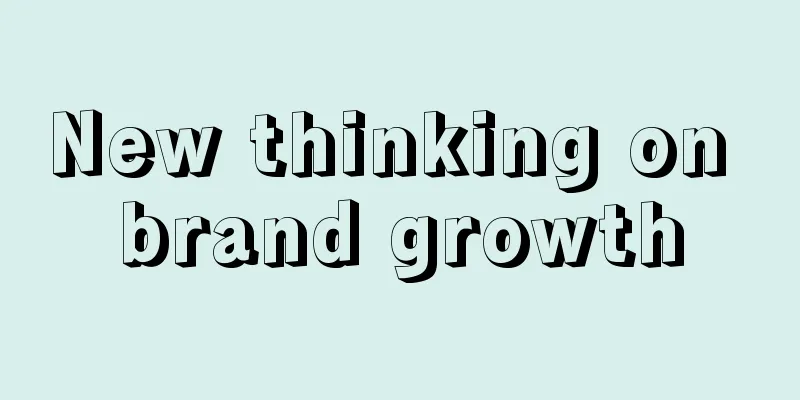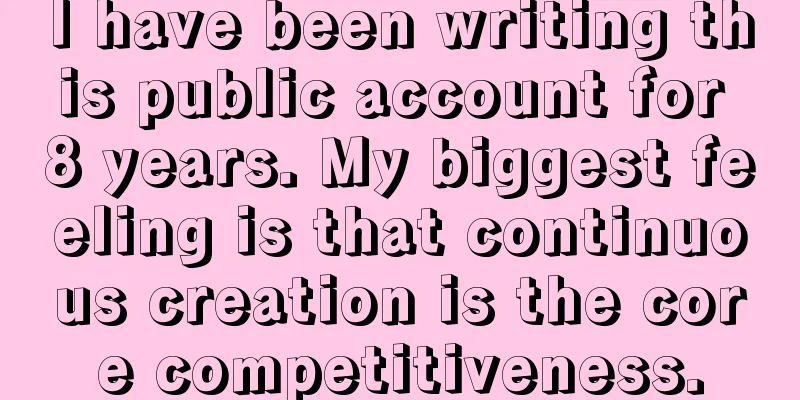New thinking on brand growth

In today's social and business environment, it is far from enough for start-up and growing brands to gain a foothold and grow by simply relying on innovative ideas and high-quality products. If big brands want to survive and grow, they need the courage to change the industry; growing brands need the desire to continuously iterate their core capabilities; start-up brands need unique and extreme development thinking. Today, let's talk about some new thoughts on brand growth. New thinking on brand growth 1: Find the user circle that likes you, the brand needs "definition" rather than "positioning"Luckin Coffee is a brand that has been watched by industry insiders and the public in recent years: Luckin Coffee was successfully listed on the Nasdaq in the United States in just two years, and obtained a market value of nearly 10 billion US dollars. Then it was exposed for financial fraud, and there was sufficient evidence from the whistleblower. Then Luckin Coffee was delisted and its founder Lu Zhengyao was punished. Under such a blow, everyone thought that Luckin Coffee would definitely fail, and slowly disappeared from the market. But it took less than two years for Luckin Coffee to recover. By 2023, Luckin Coffee began to make a profit. And it was after three years of impact. In the process of Luckin Coffee's brand growth, many professionals have analyzed Luckin Coffee, but these analyses, in summary, are mainly two problems. The first question is: Is it Luckin’s brand positioning of “professional coffee, fresh style” that influences users’ purchasing behavior, or is it the marketing strategy of “Who doesn’t love the little blue cup” or “First cup free” used in advertisements that plays a more important role? The second question is: Was it the fission discount that saved Luckin Coffee, or did factors such as stable quality, speed and convenience, unified image and transparent supply chain play a more critical role? In fact, this problem is not that complicated. Many brands have also done fission, and have also offered the first cup for free, or even the first order for free, but in the end consumers left these brands. As a brand, letting users taste Luckin for the first time may be affected by many factors, including advertising, spokespersons, brand image, price and convenience; but for Luckin to be able to turn around, there must be "a group of people, a circle" who really accepted it, liked it, and have always been fond of it (of course, its pricing strategy is also very superb, with a lower price than Starbucks, capturing a group of consumers who are willing to drink good coffee but are unwilling to spend so much money to buy Starbucks coffee. If Luckin raises the price to the same as Starbucks, it will indeed lose a large user group) In business, the biggest mistake made by many professionals and unsuccessful enterprises is to only talk about positioning, as if "positioning" can win the market. But in fact, even if you have enough experience to carry out the so-called "saturation attack", if there is no price strategy support, you can't lock in a "super circle". Let's think about it, even if Luckin Coffee's advertisements were everywhere, how many people were impressed by the positioning? Feihe advertises everywhere that it "understands the physique of Chinese babies better". If it is not about 50 yuan lower than Aptamil and the membership price, the positioning of Feihe milk powder will not have a "magic effect". In today's business environment, all ambitious brands claim to be user-centric and are determined to create an experience that exceeds user expectations. Unfortunately, they are still unable to effectively describe who chooses their brand, when, and why in what scenario? Many idealistic entrepreneurs in various industries have established user connection as the core of their operations, but most of them think that "Weihong Douhu" is connection, or that private domains have achieved connection, not to mention what to do after the connection? As a brand creator or practitioner who is determined to change and innovate the industry, you first need to establish cognition with "positioning" and "users". The first cognition established: Big data of social attributes is meaningless, only the exploration of "super circles" is valuable Age, income, occupation, interests and other data under big data are difficult to cover the habits and behavior patterns of fragmented new consumer groups. Only through granular individual research and exploration, and then building the commonality of circles, can we truly and effectively tap into people's beliefs, interests, habits and emotions. Individuals form groups, and super circles bring together people of the same type. There are no more than 1,000 different types of people in this world. Therefore, effective information only requires "observation" of "a very small number of people" to draw out circles, which in turn affects brand marketing strategies. This has been pointed out by Steve Jobs: "People don't know what they want until you put it in front of them. For this reason, I never rely on market research. Masuda Muneaki's Tsutaya Bookstore and Suzuki Toshifumi's 7-11 have proven to be effective. When there were no cars, consumers wanted a faster carriage, and they didn't even know there was such a product in the world. If you want to transform a brand or a company, you don't need to study millions of customers, just 100 people are enough. The "7C Methodology" proposed by Martin Lindstrom, the author of "Brand Brainwashing" and "Pain Points" and a global brand expert, also provides a systematic method: collection, clues, connection, association, cause and effect, compensation and concept. The second cognition established: the transformation from a "positionist" to a "definitionist". In today's business era, brand building is a bit like the philosophers of the pre-Qin era: a hundred schools of thought contended, a hundred flowers bloomed - they promoted themselves with unique ideas, found circles, attracted followers, and then achieved success in the world: Confucianism, diplomacy, Mohism, Legalism, military science, agriculture, and miscellaneous schools. Analogous to positioning, it is difficult to position yourself/brand through promises, attributes, class/status, and attract users to "invest"; instead, you need to "define" yourself with some new concept, find the "super circle" of your brand, and then gain "followers". The business environment in the next five years will reflect the following characteristics. The first characteristic: the phenomenon of consumer circles is becoming more and more obvious. Behind the "subculture" that can be initiated at any time, gathered at any time, and trendy at any time, there are more and more small circles, small cognitions, small labels, small scenes, small communities, small cultures, small lifestyles, and small values. With the help of mature digital infrastructure, these small circles have become new "user positions" and the foundation for supporting new business and new categories. The second characteristic: circles are developing warmer user relationships. This means truly empowering and finding meaning for every individual; it means that mobile time and fragmented space are reconnected and integrated; it also means that online activity and market prosperity go hand in hand. The third characteristic: In the past, the battle for user minds was to seize more user minds, while the battle for new consumer user minds is about relationship connection and relationship value-added. The depth of connection means more business opportunities. Because of these three characteristics, the focus of brand marketing has changed a lot: from function to benefit, then to experience, and now to "circle recognition". In other words, brand marketing has shifted from emphasizing what it has, to what it does, to what you will feel, and finally to who you are. Following the changes, defining yourself with new ideas, defining communities with interests, defining tribes based on attitudes, defining lifestyles based on consensus, and finding interest circles that match the brand to start a dialogue are the more suitable, more efficient, and faster matching methods for the coffee track. Only with this kind of thinking can the category strategy take effect. The third cognition established: from defining the present to defining future expectations Who we are is far less important than who they are, and the secret to building stronger connections is to define your users. However, just knowing who they are is still a low-dimensionality; the truly valuable definition of users is to define their desired ideal state, because every purchase of a product will shape their identity. It is meaningless to define the user itself and the current situation. Only through user definition can we gain insight into potential needs - understanding, respecting, amplifying and undertaking individual life tasks. Therefore, our focus should be on why, not who does what. When defining users, many brands usually only describe their current state and focus on this state in marketing promotion. Let's take coffee, which is familiar to everyone, as an example. Coffee is developed for outdoor scenes, such as camping, grassland, fishing, etc. For outdoor coffee, users don't really want to drink a cup of coffee to refresh themselves, but drink coffee to achieve progress in life: this may be to show their taste in camping, or to add a sense of ritual on the grassland; it may also be to match the sense of reward brought by music? Or give everyone a surprise; or it may be to show that "I" have an unruly soul and a sentiment of "poetry and distance"? When defining users, we should use you as the benchmark, magnify a certain interest and passion, and use your preferences as the standard for selecting users. According to your circle, interests, beliefs, etc., find something unique and do it to the extreme, and achieve great things from this small. Invite participatory co-construction, and become a private reserve for the interests of this type of users, a place to express new life attitudes, and a place to interact with new consumer spirits. Find a new role, and transform from a relationship connector to a relationship value-added person - help users achieve a better self. This approach also applies to treating employees and partners. The truth that is not the truth, rather than risking no one liking you in the end by trying to please everyone, it is better to only look for those who are likely and willing to be your true friends. So, finding people who like you and inspiring them to join your ecosystem, become partners, and grow together may be the first thing every new brand should consider. New thinking on brand growth 2: Carry out differentiation to the endDifferentiation is the art of standing out in brand competition, which has long been a consensus among brand people. However, if a brand wants to stand out, it must carry out differentiation to the end. The first level of differentiation: being different. The starting point of differentiation must begin with the appearance of the product. First of all, vision is the main reliance of human beings. Everyone is more likely to remember the same piece, so uniform color is the first element of being different. Secondly, being different is not about providing more products or products that follow the trend, but about providing different products. Then, from a psychological point of view, being different not only includes visual impact, new products, new concepts, and new spaces, but also requires more "systematicity". Only with systematicity can it stand out. Finally, being different requires boldness, innovation, surprise and clarity. Whether it is "clear and unique" enough can be truly differentiated through replacement testing. The second level of differentiation: extraordinary. The root of extraordinary is the high ground of aesthetic concepts, the powerful combination of logical reasoning and inspiration. Aesthetics is always pleasing! In order to be extraordinary and have great charm, it must also resonate with users. The third level of differentiation: uniqueness. First of all, uniqueness can be original intention, dream, concept, culture, etc., or it can be anything such as product, space, service, experience, service, etc. The premise is that you must make this uniqueness to the extreme, so that users can easily notice it, choose it, and share it. In addition, the danger is often not in over-focus, but in insufficient focus. An unfocused brand includes so much that it does not represent anything. In contrast, a unique brand knows exactly what it is, what it wants, why it is unique, and why people want it. New thinking on brand growth 3: Consumer motivation thinking, what is the motivation for consumers to choose you?Give me Melatonin as a gift, drink Wanglaoji if you are afraid of getting angry, drink Red Bull/Dongpeng Special Drink when you are tired, and drink 0-sugar Yuanqi Forest. This is the first level of consumer motivation. The second level of motivation is that we need to understand that consumers will also examine the meaning of consumption, not only in terms of possession and acquisition, but also in terms of emotional satisfaction, life testimony, self-construction, etc. At the same time, the infinitely segmented lifestyles and the emphasis on marginal, fast and discrete mobile fragmented scenes will inevitably require different motivation triggering mechanisms. However, the five consumer motivations of consumers, emotions, values, identity, habits, and norms are eternal. We need to find out which motivation triggers the consumer's consumption motivation. Once the motivation is triggered, the purchase is bound to happen. Author: Liu Yichun, WeChat official account: "Liu Yichun's brand product innovation" |
<<: Breaking out of the Red Ocean | Good content drives new brand growth
>>: Brand Growth│Brand Launch Guide
Recommend
Understanding Xiaohongshu's Commercial Traffic in One Article
90% of brands and merchants do not correctly under...
Contemporary workers are forced to suffer from "word-pleasing syndrome"
Do you like to add modal particles at the end of s...
Young people gather on Xiaohongshu
In the world of social media, traffic is often kin...
Will the curse of lululemon be broken by Alo Yoga?
In the tide of consumerism, how brands can maintai...
Live e-commerce in 2022: End and rebirth
With the entry of more players, the story of the l...
What questions do you have about joining Shopee? FAQ
The first step to becoming a Shopee seller is to s...
How to calculate eBay advertising fees? How to set up eBay advertising?
When opening a store on eBay, if you want more tra...
What are the requirements for binding a credit card to Amazon? How to unbind a credit card?
We can buy some overseas products on the Amazon pl...
Is it good for cross-border e-commerce to do tax accounting? What are the requirements?
With the development of the Internet and the globa...
Where can I find an Amazon investment manager? What issues should I solve before registering on Amazon?
As the largest cross-border e-commerce platform, m...
When is Amazon Black Friday Cyber Monday? Can I cancel my Amazon Prime membership after the trial?
Every year, the "Black Friday shopping season...
Play with the advertising copy
Advertising copy is the bridge of communication be...
Can I continue to optimize Shopee products? How to operate?
Nowadays, although the profits of cross-border e-c...
Notice on some business adjustments during the 2022 National Day of Dunhuang.com
The golden National Day week is coming soon. In or...
Freemium vs Free Trail: Which one has better business growth?
When deciding on a product's business model, w...









